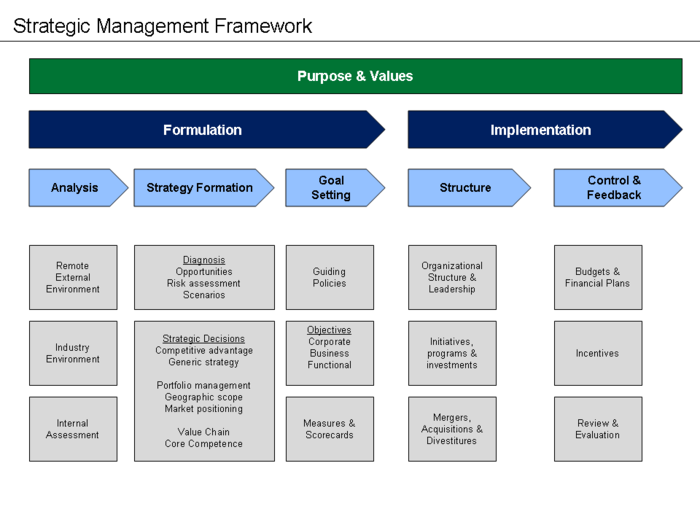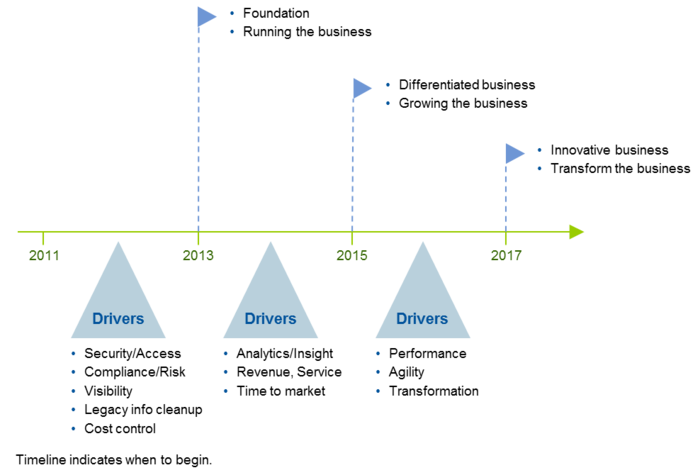Description
There are many definitions for Business Strategy proposed by multitudes of authors. The definition can be aggregated as either separately or in combination. Strategy is a high level plan to achieve one or more goals under conditions of uncertainty. According to Porter there are three principles underlying strategy: creating a “unique and valuable [market] position”, making trade-offs by choosing “what not to do”, and creating fit by aligning company activities with one another to support the chosen strategy(1). Strategy can also be seen as a coherent set of analyses, concepts, policies, arguments and actions that respond to high stakes challenge (2). Business is defined as an organization involved in the trade of goods, services or both to consumers (3). Business Strategy can be expressed in the form of Strategic Management Frameworks (Figure 1) or the strategy map (Figure 2).
Figure 1

Figure 2

Overview
Business strategy is pertinent to the architect as it is the foundation for his value delivery to the organization. The capability to review the business strategy is important for the architect to contribute in terms of technology and architectural aspects during the lifecycle of business strategy management. The architect has many roles to carry out during the Business Strategy management and lifecycle. The main role is to be the technology strategist and contribute on how technology can be leveraged to achieve the outcomes for the business strategy (6).
Proven Practices
The architects role can be segregated according to the phases of the Management of the business strategy (7). During the development phase, to be an active part of the team developing the business strategy, contributing on the architectural and technology aspects during the strategic analysis and formulation of the business strategy and maintaining traceability to the mission vision and value.
During the translation of strategy, contributing to the definition of strategic objectives and themes, selection of measures and target; and the strategic initiatives leveraging on technology to increase value of the business outcome.During the planning for operations phase contributing to improvement of key processes, development of operations plan, planning for resource capacity and preparing the budget.
During the execution of the initiatives, to identify and take ownership of technology related execution, facilitating and enabling the business owners in executing the processes and initiatives. During the monitoring and learning phase, to take an active part in the strategic an operational review. During the testing and adaptation of the strategy, taking part in the profitability analysis, strategic correlation analysis and examination of emerging strategies.
The capability to apply the architecture principles to the business strategy during the lifecycle management is important to deliver value to the organization. The role of the architect is to contribute and add value to the business outcome and strategy execution using established frameworks, diagrams and metrics. The frameworks are used to form the foundation for the strategic execution and form the basis for communication to relevant stakeholders and subject matter experts. The main use of architectural artifacts are to communicate complicated abstractions in the form of diagrams and metrics to subject matter experts. Diagrams are used to communicate complicated and abstract concepts in a concise visual manner to foster understanding of the concept while maintaining the real-world complexity. Metrics are used to show the complicated relationships between attributes and measures to the relevant stakeholders(8).
The most important role the architect have is to construct a traceability matrix from technology investments to the business outcomes stipulated in the business strategy to deliver value of the investments to the organization. The traceability must include the relationship of the business to IT strategy and the linkages of the information technology to the business infrastructure and processes (please refer Figure 3). One example is the technology information alignment perspective where the Business Strategy is the driver, the role of top management as a technology visionary, the Information System management serve as the technology architect and the performance criteria is technology leadership (9).
Figure 3

Sub-Capabilities
Business Strategy Formulation
| Iasa Certification Level | Learning Objective |
|---|---|
| CITA- Foundation |
|
| CITA – Associate |
|
| CITA – Specialist |
|
| CITA – Professional |
|
Strategic Management System
| Iasa Certification Level | Learning Objective |
|---|---|
| CITA- Foundation |
|
| CITA – Associate |
|
| CITA – Specialist |
|
| CITA – Professional |
|
Alignment to IT of Business Strategy
| Iasa Certification Level | Learning Objective |
|---|---|
| CITA- Foundation |
|
| CITA – Associate |
|
| CITA – Specialist |
|
| CITA – Professional |
|
Resources
Blogs/Webcasts/News/Reference Resources:
- https://en.wikipedia.org/wiki/Strategy
- Good Strategy. Bad Strategy. The difference and why it matters. Richard P Rumelt. Crown Business. New York.2011
- https://en.wikipedia.org/wiki/Business
- https://en.wikipedia.org/wiki/Strategy
- Kaplan, R.S. and Norton D.P., HBR Jan 2008. hbr.org
- IASA Lecture Business Architecture
- Kaplan, R.S. and Norton D.P., HBR Jan 2008. HBR.org
- Enterprise Architecture at Work. Marc Lankhorst et al. Modelling, Communication and Analysis. Third Edition. 2013. Springer. Berlin Heidelberg.
- Strategic Alignment Model. Henderson and Venkatraman IBM Systems Journal, Vol 38, No 273, 1999
Author
 Dr. Ariffin Mokhtar
Dr. Ariffin Mokhtar
Director of Health Informatics
Dr. Ariffin Marzuki bin Mokhtar is a National Specialist Registered (NSR) Anesthesiologist that graduated from the Universiti Kebangsaan Malaysia (UKM) (2002), and is currently practicing as a Consultant Anesthesiologist at the National Heart Institute (Institut Jantung Negara-IJN), Malaysia. He is a Certified Professional in Health Information Management and Systems (CPHIMS), a Certified IT Architect- Associate (CITA-A) and is Open Group Architecture Framework 9.1 Certified.
Apart from clinical practice in Cardiac Anesthesia and Critical Care, his current job scope as the Director of Health Informatics (DHI) for IJN includes implementation of IJNs Enterprise Architecture initiatives, advising the IJNs BOD and Management on matters pertaining to Information system Governance, best practices and supporting the IJNs accreditations initiatives that includes the JCI, MSQH, ISO 9001:2008, ISO 27001 and HACCP. He was involved with the JCI accreditation as a working committee member for JCI accreditation from 2007 and a permanent member of the Quality Committee up to 2013, after which he assumed the DHI post.
His current interest apart from clinical work in Anesthesia and Critical Care are the use of technology as an enabling tool to deliver high quality and safe care to patients including training and education of healthcare providers in using technology tools, development of clinical pathways, modeling clinical care, performance measure, healthcare organization transformation governance and management, healthcare business architecture and activity based costing and management.







